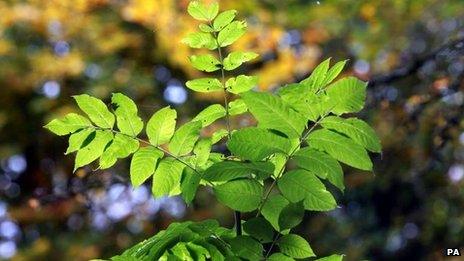Ash dieback: 'Wash after visiting woods' plea
- Published
- comments

There are fears that wind spores could carry the disease out of East Anglia
The environment secretary has urged the public to wash their dogs and boots and even their children after visiting wooded areas, to help stop the spread of a fungus which is killing ash trees.
Owen Paterson spoke after the government's emergency committee Cobra met to discuss the ash dieback menace.
Some 100,000 trees have been destroyed in the UK, where East Anglia has been particularly badly affected.
The infection has affected some 90% of ash trees in Denmark.
Ministers are concerned that the fungus could be present on fallen leaves and could be transferred via leaf mould.
Mr Paterson told the BBC: "Everyone should be responsible and if they do visit a wood just make sure they wash their boots, wash their dog, whatever's been running around the leaves, wash their child, to make sure they don't transfer to the next wood."
About 2,500 10sq km sites across the UK are being surveyed to establish how far the disease has spread, according to the Department for Environment, Food and Rural Affairs (Defra).
Amid criticism from Labour, Mr Paterson denied the government had been slow to act when the infection was first discovered.
He said: "This disease was only established here on 7 March. During the summer, trees are not planted so a programme of inspection has gone on during which 100,000 trees have been destroyed.
"But as I have also made clear, this disease as we discovered recently has possibly blown in.
"It's on the basis of that information that we're now working together right across government at the highest level, using expertise in every department, to bear down on the disease," he said.
Ash dieback, also known as Chalara dieback, is caused by the fungus Chalara Fraxinea.
The disease was first discovered in the UK in February in a consignment of trees imported from the Netherlands by a nursery in Buckinghamshire.
The Forestry Commission, external has said it has since been found at sites across England and Scotland, including Leicester, South Yorkshire, County Durham and in Knockmountain Woods near Glasgow.
The trees at all the locations above had been grown from young ash saplings obtained from nurseries within the past five years.
In October, scientists confirmed a spate of cases in Norfolk and Suffolk in trees not planted recently, which appear to form a wider infection zone.
The BBC's Jeremy Cooke on how to spot an infected ash tree
Mobile app
Shadow environment secretary Mary Creagh has accused the government of "dithering" over the issue and has expressed concerns over cutbacks to the Forestry Commission's budget.
But environment minister David Heath denied there had been any cut back in resources "applied to plant health and tree health in this country".
Visible symptoms of ash dieback include leaf loss and crown dieback in affected trees and it can lead to tree death.
The disease has been listed as a quarantine pathogen under national emergency measures and the Forestry Commission has produced guidance, external, including help on how people can identify possible signs, external of infection.
Experts are urging people to report suspected cases of dieback in order to prevent the spread of the disease to the wider environment becoming established.
An app, Ashtag, external, has been launched to try to map the spread of the disease by allowing users to upload pictures and report possible sightings to a team which will pass any information to the Forestry Commission.
- Published6 November 2012
- Published3 September 2012
- Published27 October 2012